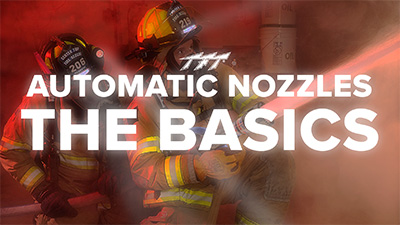What is an Automatic Nozzle?
The automatic nozzle is the youngest fire nozzle design on the market. The design for it was sketched on a dinner napkin in 1968 by Clyde McMillan, the founder of Task Force Tips. McMillan developed the nozzle to make your job as a firefighter easier and safer.
There are a lot of opinions out there about the automatic nozzle. Some firefighters love the automatic nozzle while others don’t like using them. Let’s dive into how it works and who it might be right for.

What is an Automatic Nozzle?
An automatic nozzle is a combination firefighting nozzle that contains a spring-loaded baffle. This baffle is able to maintain a specified pressure throughout a wide flow range. This means that as your flow drops, the exit orifice for the nozzle gets smaller and if your flow increases, it gets larger.
How Does an Automatic Nozzle Work?
For the most part, an automatic nozzle works just like any other combination nozzle. You open, close, and gate the nozzle using the bail handle. You can also adjust your flow pattern like any other combination nozzle.
The baffle is where the automatic nozzle differs from other combination nozzles.
 |
 |
 |
The baffle for the automatic nozzle has gotten some updates over the years, but the basic concept has stayed the same. The baffle contains a calibrated spring. This spring allows the baffle to move in and out to maintain a specific pressure throughout a flow range.
As explained above, when your flow lowers, the baffled moves to make the exit orifice smaller and maintain the pressure of the nozzle. Likewise, for larger flows the exit orifice gets larger to maintain the pressure.
Learn more about how an Automatic Firefighting Nozzle works here.
Pros and Cons of an Automatic Nozzle
Every handline nozzle has pros and cons associated with using it. Here are a few pros and cons you might hear about with the automatic.
Pros
- The automatic maintains pressure throughout a flow range. This means your stream reach is always optimized, even with low flows.
- Since this is a combination nozzle, you have the option of using a straight stream or fog pattern based on your fire ground needs.
Cons
- The automatic nozzle does have more moving parts than a simple smooth bore and some other nozzles. If you need repairs to any internal mechanisms, it may be more complex of a job.
- Because the stream is optimized for reach with a maintained pressure, you may struggle to know exactly what you are flowing. The solution to this is to use a flow meter and utilize training to get a feel for the nozzle and flows.
Are Automatics Still Used in the Fire Service?
Yes! Automatic handline nozzles are used by many fire departments who enjoy the optimized use of their water. They also enjoy the pressure stability and limited back and forth it requires between the nozzle operator and pump operator.
Consistent pressure also helps maintain stream reach. Many departments find this feature desirable, especially when they need to operate at lower flows.
Is an Automatic right for you?
The decision to use an automatic nozzle is up to you and your crew! Each firefighter has their preferences in nozzles and the best way to find yours is to try them, train with them, and stay informed of the latest research and innovations. It’s also important to consider the needs of the fire ground you typically experience. You may end up preferring an automatic for one type of fire and favoring another style in a different scenario.
Your water supply may also impact which nozzle you choose. If your department has an inconsistent water supply or regularly drafts from static sources, you may find yourself looking for nozzle options that optimize your water supply. An automatic nozzle is one solution for these scenarios.
Do you have more questions about Automatic Nozzles? Find answers to nine common questions here.
